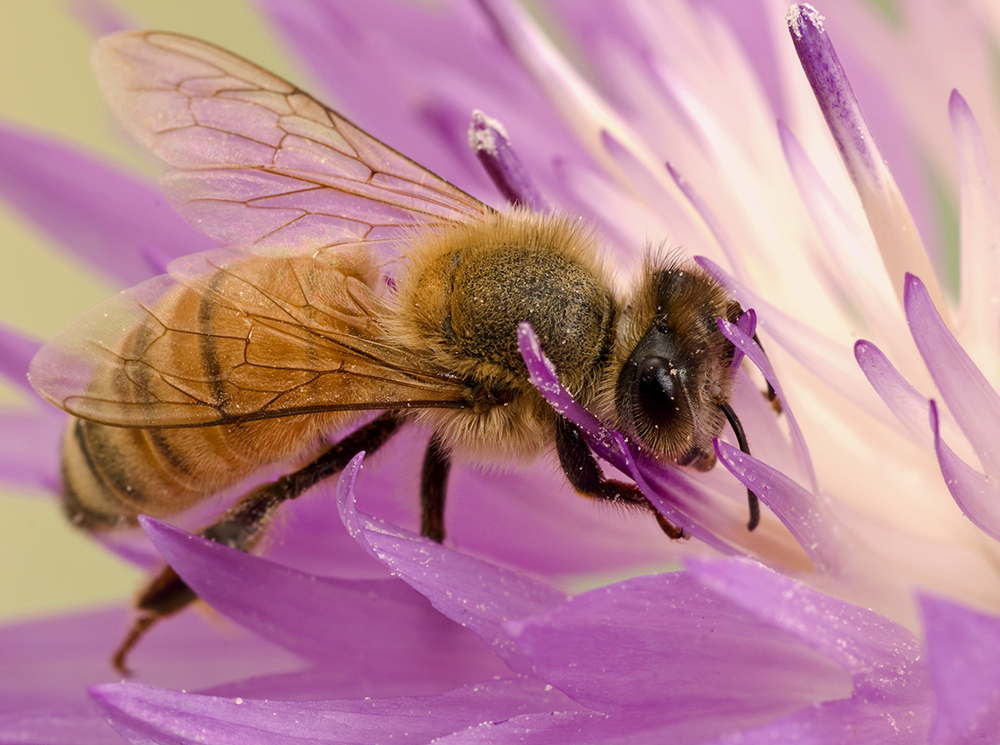by Patty Milligan
Whether or not you’re a honey maven, you can turn your garden into a bee haven! In other words, you don’t have to become a beekeeper to help out the bees. Honeybees, and their native counterparts, are under siege, as you’ve probably heard, and you can create a refuge for the beleaguered creatures by implementing (or continuing!) a few simple gardening strategies.
Gardens are good….aren’t they?
“But,” you might ask, “Isn’t my garden already a refuge for bees just because it’s, well, a garden?”
You would think! But gardens are often planted with people, not bees, in mind. Flowers are bred for show rather than for their pollen and nectar loads or easy pollinator access. What pleases our eyes doesn’t always suit them. Ironically, the next-door, eyesore—a vacant lot rife with weeds and mud puddles—is a more pollinator-friendly place than the wood-chipped, neatly-clipped yard with the ultra-green expanse of lawn and uniform petunia borders.
BUT WAIT! Don’t start digging up your lawn to plant Canadian thistle just yet! Gardening for bees doesn’t mean embracing chaos! A few gentle adjustments will help—and you may find that you’re already doing some (or all) of them. You may also choose to adapt part of your garden, not all of it. Lola Canola’s advice for planting for bees is really quite simple.
Nobody wants bees around…do they?
“But,” you ask again, “Why would I WANT to plant for bees, those irritating little stinging machines?”
There are so many ways to answer this niggling question! Curious people might find bees fascinating to watch (hey, this could be an ideal way to alleviate children’s nature deficit syndrome!). Bees don’t sting unless disturbed, and most of Alberta’s indigenous bees are stingless anyway. (To be on the safe side, anyone with a bee-venom allergy should have an Epi-pen!). Altruistic individuals probably want bees around because it’s a good thing for the planet. Disease, pesticide use, and habitat loss are putting a strain on our wee pollinators. A small effort by many gardeners could alleviate that strain. FYI, the bandwagon is already on the move—even Burt’s Bees has been encouraging its customers to plant for bees by giving them free packets of wildflower seeds. Finally, the pragmatists simply want MORE FRUIT AND VEGETABLES! Bees increase yields—it’s that simple. (They say we can thank insect pollinators for 30% of our food production—that’s 1 out of every 3 bites.) So finally, here are some of those long-awaited tips:
Lola’s Advice for Turning your Garden into a Bee Playground
(If it isn’t already!)
1) Plant lots of different kinds of flowers. Plant a mixture of perennial and annual, native and exotic, short and tall. A diversity of flowers attracts a diversity of pollinators. Planting in masses works best for bees who will often overlook single plants in favour of clumps.
2) Use plants with single flowers. Pollinators have a hard time accessing the nectar and/or pollen in those beautiful but complex double blossoms. Bees are most attracted to yellow blooms but they also like blue-green/blue, mauve, purple and red.
3) Extend the blossoming season. Alberta’s season is short and intense. Two honey flows dominate it: dandelion (mid-May to mid-June) and alfalfa/clover/canola (mid-July to mid-August). Pollinators will appreciate any plants that blossom earlier, later, or during that gap in late June/early July.
4) Boost your weed tolerance. Many plants that we hate (thistle, clover, dandelion, sweet clover) are FANTASTIC for bees. If you (or your neighbours) can tolerate them, let them bloom and then cut them down or dig them out immediately. Minimizing or eliminating pesticide use is key to growing a pollinator-friendly garden.
5) Make trees part of the equation! Pollinators love flowering fruit trees, but they also love trees with “less obvious” flowers. If you stand under a blossoming Manitoba Maple in May, you’ll hear the whole thing buzzing! Pussy willow, oak, poplar, ash, and shrubs like caragana and cotoneaster are also important early sources of pollen. Bees like them best planted in avenues or in groups.
6) Encourage wet spots. Bees need access to water. Shallow pools or puddles are ideal. Throw some twigs or a handful of dried grass on top of your rain barrel so they can drink more easily.
7) Plant flowers that are most popular with the pollinating set. You’ve seen which flowers in your garden are party central! Plant more of them! Many garden centres and seed companies highlight flowers that attract “showier” pollinators—hummingbirds and butterflies. These flowers will have a higher nectar load and they MAY also be attractive to bees (depending where the nectar is situated—bees have shorter tongues than hummingbirds or butterflies) so you might ask a staff member or just take a chance. A few companies identify “bee-friendly” flowers—West Coast Seeds (BC), Agrestal (ON), and Bedrock Seed Bank (AB) come to mind. Here are some plants to consider as you make your seed selections: alfalfa, bee balm, bergamot, borage, buckwheat, echinacea, gaillardia, hyssop, lavender, phacelia, sage, and thyme, just to name a few!
For more detailed information about gardening for bees, visit the Canadian Wildlife Federation’s excellent website. For more detailed information about pollinators check out the fantastic Pollination Canada website.


